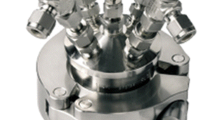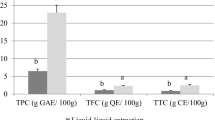Abstract
Two different processes have been developed for the recovery of hydroxytyrosol (HT) and 3,4-dihydroxyphenyl glycol (DHPG) from olive oil mills waste. The antioxidant activity of several effluents has been characterised by four “in vitro” tests: antiradical capacity (ARC), ferric reducing power (P R) and inhibition of primary and secondary oxidation in lipid systems. HT-containing effluents exhibited higher or similar activity in ARC and P R than equimolecular quantities of vitamins E and C. In oxidative tests they were between both assayed vitamins. Except for commercial Hytolive®2, activities correlated with HT concentration of each sample. DHPG-containing effluent had higher activities than a solution with the same concentration of the synthetic DL-DHPG. This effluent was the most active in ARC and P R tests, its activity being similar to vitamin E in the inhibition of primary oxidation. Both phenolic compounds showed antagonist effect when they coeluted, except for P R assay. These results suggested that due to the low-cost procedure and to the antioxidant activity of effluents, they could be valuable as natural additives for food, pharmaceutical and cosmetic industries.






Similar content being viewed by others
Abbreviations
- HT:
-
hydroxytyrosol
- DHPG:
-
3,4-dihydroxyphenyl glycol
- DPPH:
-
2,2-diphenyl-1-picrylhydrazyl (free radical)
- ABAP:
-
2,2′-azobis(2-amidinopropane) dihydrochloride
- SDS:
-
sodium dodecylsulphate
- RT:
-
retention time
- EC50 :
-
amount of antioxidant necessary to decrease the initial absorbance by 50%
- EC25 :
-
amount of antioxidant necessary to decrease the initial absorbance by 25%
- ARC:
-
antiradical capacity
- P R :
-
reducing power
- QE:
-
quercetin equivalent
- POIC:
-
primary oxidation inhibition capacity
- TBARS:
-
thiobarbituric acid reactive species
- R :
-
correlation coefficient
References
Owen RW, Haubner R, Mier W, Giacosa A, Hull WE, Spiegelhalder B, Bartsch H (2003) Isolation, structure, elucidation and antioxidant potential of the major phenolic and flavonoid compounds in brined olive drupes. Food Chem Toxicol 41:703–717. doi: 10.1016/S0278-6915(03)00011-5
Pérez-Jiménez F (2005) International conference on the healthy effect of virgin olive oil. Eur J Clin Invest 35:421–424. doi: 10.1111/j.1365-2362.2005.01516.x
Tuck KL, Hayball PJ (2002) Major phenolic compounds in olive oil: metabolism and health effects. J Nutr Biochem 13:636–644. doi: 10.1016/S0955-2863(02)00229-2
Aruoma OI (2003) Methodological considerations for characterizing potential antioxidant actions of bioactive components in plant foods. Mutat Res–Fundam Mol Mech Mutagen 523:9–20
Covas MI, de la Torre K, Farré-Albaladejo M, Kaikkonen J, Fitó M, López-Sabater C, Pujadas-Bastardes MA, Joglar J, Weinbrenner T, Lamuela-Raventós RM, de la Torre R (2006) Postpandrial LDL phenolic content and LDL oxidation are modulated by olive oil phenolic compounds in humans. Free Radic Biol Med 40:608–616. doi: 10.1016/j.freeradbiomed.2005.09.027
Pazos M, Alonso A, Fernández-Bolaños J, Torres JL, Medina I (2006) Physicochemical properties of natural phenolics from grapes and olive oil byproducts and their antioxidant activity in frozen horse mackerel fillets. J Agric Food Chem 54:366–373. doi: 10.1021/jf0518296
Romero C, Brenes M, García P, Garrido A (2002) Hidroxytyrosol 4-β-glucoside an important phenolic compounds in olive fruit and derived product. J Agric Food Chem 50:3835–3839. doi: 10.1021/jf011485t
Ryan D, Antolovich M, Prenzler P, Robards K, Lavee S (2002) Biotransformation of phenolic compounds in Olea europaea L. Sci Hortic 92:147–176. doi: 10.1016/S0304-4238(01)00287-4
Fabiani R, De Bartolomeo A, Rosignoli P, Servili M, Montedoro GF, Morozzi G (2002) Cancer chemoprevention by hydroxytyrosol isolated from virgin olive oil through G1 cell cycle arrest and apoptosis. Eur J Cancer Prev 11:351–358
Visioli F, Grande S, Bogan P, Galli C (2004) The role of antioxidants in the Mediterranean diets: focus on cancer. Eur J Cancer Prev 13:337–343
Carrasco-Pancorbo A, Cerretani L, Bendini A, Segura-Carretero A, Del Carlo M, Gallina-Toschi T, Lercker G, Compagnone D, Fernández-Gutierrez A (2005) Evaluation of antioxidant capacity of individual phenolic compounds in virgin olive oil. J Agric Food Chem 53:8918–8925. doi: 10.1021/jf0515680
Morello JR, Vuorela S, Romero MP, Motilva MJ, Heinonen (2005) Antioxidant activity of olive pulp and olive oil phenolic compounds of the arbequina cultivar. J Agric Food Chem 53:2002–2008. doi: 10.1021/jf048386a
Miró-Casas E, Covas MI, Farre M, Fito M, Ortuño J, Weinbrenner T, Roset P, de la Torre R (2003) Hydroxytyrosol disposition in humans. Clin Chem 49:945–951. doi: 10.1373/49.6.945
Cuomo J, Rabovskiy AB (2001) Antioxidant compositions extracted from olives and olive by-products. Patent no. WO0145514
Crea R (2002) Method of obtaining a hydroxytyrosol-rich composition from vegetation water. Patent no. WO0218310
Bai C, Yan X, Takenaka M, Sekiya K, Nagata T (1998) Determination of synthetic hydroxytyrosol in rat plasma by CG-MS. J Agric Food Chem 46:3998–4001. doi: 10.1021/jf980451r
Espin JC, Tomás-Barberan FA, García MC, Ferreres F, Soler C, Wichers HJ (2002) Enzymatic synthesis of antioxidant hydroxytyrosol. Patent no. WO02016628
Capasso R, Evidente A, Avolio S, Solla F (1999) A highly convenient synthesis of hydroxytyrosol and its recovery from agricultural waste waters. J Agric Food Chem 47:1745–1748. doi: 10.1021/jf9809030
Visioli F, Romani A, Mulinacci N, Zarini S, Conte D, Vincieri FF, Galli C (1999) Antioxidant and other biological activities of olive oil mill waste water. J Agric Food Chem 47:3397–3401. doi: 10.1021/jf9900534
Fernández-Bolaños J, Heredia A, Rodríguez G, Rodríguez R, Guillén R, Jiménez A (2002) Method for obtaining purified hydroxytyrosol from products and by-products derived from the olive tree. Patent no. WO02064537
Fernández-Bolaños J, Rodríguez G, Rodríguez R, Heredia A, Guillen R, Jiménez A (2002) Production in large quantities of highly purified hydroxytyrosol from liquid-solid waste of two-phase olive oil processing or “alperujo”. J Agric Food Chem 50:6804–6811. doi: 10.1021/jf011712r
Bianchi G, Pozzi N (1994) 3,4-dihydroxyphenylglycol, a major C6-C2 phenolic in Olea europeae fruits. Phytochemistry 35:1335–1337. doi: 10.1016/S0031-9422(00)94849-0
Allouche N, Fki I, Sayadi S (2004) Toward a high yield recovery of antioxidants and purified hydroxytyrosol from olive mill wastewaters. J Agric Food Chem 52:267–273. doi: 10.1021/jf034944u
Pieretti S, Digiannuario J, Capasso A, Nicoletti M (1992) Pharmacological effects of phenylpropanoid glycosides from Orobanche hederae. Phytother Res 6:89–93
Andary C, Wylde R, Maury L, Heitz A, Dubourg A, Nishibe S (1994) X-ray analysis and extended NMR study of oraposide. Phytochemistry 37:855–857. doi: 10.1016/S0031-9422(00)90370-4
Venneri MG, Del Rio G (2004) Systematic study of long-term stability of 3,4-dihydroxyphenylglycol in plasma for subsequent determination with liquid chromatography. J Chromatogr B 802:247–255. doi: 10.1016/j.jchromb.2003.08.010
Rodríguez G (2005) Aprovechamiento integral del alperujo tratado térmicamente. Desarrollo de un sistema viable para la purificación del antioxidante natural hidroxitirosol. Doctoral Thesis, University of Seville, Spain
Sánchez-Moreno C, Larrauri JA, Saura-Calixto F (1998) A procedure to measure the antiradical efficiency of polyphenols. J Sci Food Agric 76:270–276. doi: 10.1002/(SICI)1097-0010(199802)76
Sánchez-Moreno C, Larrauri JA, Saura-Calixto F (1999) Free radical scavenging capacity of selected red, rosé and white wines. J Sci Food Agric 79:1301–1304. doi: 10.1002/(SICI)1097-0010(19990715)79
Rodríguez R, Jaramillo S, Rodríguez G, Espejo JA, Guillén R, Fernández-Bolaños J, Heredia A, Jiménez A (2005) Antioxidant activity of ethanolic extracts from several asparagus cultivars. J Agric Food Chem 53:5212–5217. doi: 10.1021/jf050338i
Psarra E, Makris DP, Kallithraka S, Kefalas P (2002) Evaluation of the antiradical and reducing properties of selected Greek white wines: correlation with polyphenolic composition. J Sci Food Agric 82:1014–1020. doi: 10.1002/jsfa.1124
Ruberto G, Baratta MT (2000) Antioxidant activity of selected essential oil components in two lipid model systems. Food Chem 69:167–174. doi: 10.1016/S0308-8146(99)
Miguel G, Simoes M, Figueiredo AC, Barroso JG, Pedro LG, Carvalho L (2004) Composition and antioxidant activities of the essential oils of Thymus caespititus, Thymus camphoratus and Thymus mastichina. Food Chem 86:183–188. doi: 10.1016/j.foodchem.2003.08.031
Moure A, Cruz JM, Franco D, Domínguez JM, Sineiro J, Domínguez H, Núñez MJ, Parajó JC (2001) Natural antioxidants from residual sources. Food Chem 72:145–171. doi: 10.1016/S0308-8146(00)00223-5
Acknowledgments
The authors thank GENOSA for the supply of Hytolive®2. Financial support: Junta de Andalucía, Consejería de Innovación, Ciencia y Empresa (projects CAO01-006 and CO3-055).
Author information
Authors and Affiliations
Corresponding author
Rights and permissions
About this article
Cite this article
Rodríguez, G., Rodríguez, R., Fernández-Bolaños, J. et al. Antioxidant activity of effluents during the purification of hydroxytyrosol and 3,4-dihydroxyphenyl glycol from olive oil waste. Eur Food Res Technol 224, 733–741 (2007). https://doi.org/10.1007/s00217-006-0366-1
Received:
Revised:
Accepted:
Published:
Issue Date:
DOI: https://doi.org/10.1007/s00217-006-0366-1




